Locking Status and Earthquake Potential Hazard along the Middle-South Xianshuihe Fault
Abstract
1. Introduction
2. Data
2.1. Data Collection
2.2. Data Processing
2.3. Signal Decomposition
3. Methodology
4. Results
4.1. Locked Slip Deficit Rate of SDK
4.2. Locking Depth
5. Discussion
5.1. Stability of the Relaxation Effect
5.2. Relationship Between Seismicity and Tectonic Structures
5.3. Potential Seismic Hazard along the SDK
5.4. Limitations
6. Conclusions
Supplementary Materials
Author Contributions
Funding
Acknowledgments
Conflicts of Interest
References
- Jiang, G.; Xu, X.; Chen, G.; Liu, Y.; Fukahata, Y.; Wang, H.; Yu, G.; Tan, X.; Xu, C. Geodetic imaging of potential seismogenic asperities on the Xianshuihe-Anninghe-Zemuhe fault system, southwest China, with a new 3-D viscoelastic interseismic coupling model. J. Geophys. Res. Solid Earth 2015, 120, 1855–1873. [Google Scholar] [CrossRef]
- Wen, X.; Ma, S.; Xu, X.; He, Y. Historical pattern and behavior of earthquake ruptures along the eastern boundary of the Sichuan-Yunnan faulted-block, southwestern China. Phys. Earth Planet. Inter. 2008, 168, 16–36. [Google Scholar] [CrossRef]
- Shan, B.; Xiong, X.; Wang, R.; Zheng, Y.; Yang, S. Coulomb stress evolution along Xianshuihe–Xiaojiang Fault System since 1713 and its interaction with Wenchuan earthquake, May 12, 2008. Earth Planet. Sci. Lett. 2013, 377, 199–210. [Google Scholar] [CrossRef]
- Zhao, J.; Jiang, Z.; Niu, A.; Liu, J.; Wu, Y.; Wei, W.; Liu, X.; Yan, W. Study on dynamic characteristics of fault locking and fault slip deficit in the eastern boundary of the Sichuan-Yunnan rhombic block. Chin. J. Geophys. 2015, 58, 872–885. [Google Scholar]
- Shen, Z.-K.; Lü, J.; Wang, M.; Bürgmann, R. Contemporary crustal deformation around the southeast borderland of the Tibetan Plateau. J. Geophys. Res. Solid Earth 2005, 110. [Google Scholar] [CrossRef]
- Bohnhoff, M.; Bulut, F.; Dresen, G.; Malin, P.E.; Eken, T.; Aktar, M. An earthquake gap south of Istanbul. Nat. Commun. 2013, 4, 1999. [Google Scholar] [CrossRef] [PubMed]
- Diao, F.; Walter, T.R.; Solaro, G.; Wang, R.; Bonano, M.; Manzo, M.; Ergintav, S.; Zheng, Y.; Xiong, X.; Lanari, R. Fault locking near Istanbul: Indication of earthquake potential from InSAR and GPS observations. Geophys. J. Int. 2016, 205, 490–498. [Google Scholar] [CrossRef]
- Motagh, M.; Hoffmann, J.; Kampes, B.; Baes, M.; Zschau, J. Strain accumulation across the Gazikoy–Saros segment of the North Anatolian Fault inferred from Persistent Scatterer Interferometry and GPS measurements. Earth Planet. Sci. Lett. 2007, 255, 432–444. [Google Scholar] [CrossRef]
- Savage, J.C.; Burford, R.O. Geodetic determination of relative plate motion in central California. J. Geophys. Res. 1973, 78, 832–845. [Google Scholar] [CrossRef]
- Fialko, Y. Interseismic strain accumulation and the earthquake potential on the southern San Andreas fault system. Nature 2006, 441, 968–971. [Google Scholar] [CrossRef]
- Loveless, J.P.; Meade, B.J. Stress modulation on the San Andreas fault by interseismic fault system interactions. Geology 2011, 39, 1035–1038. [Google Scholar] [CrossRef]
- Lyons, S.; Sandwell, D. Fault creep along the southern San Andreas from interferometric synthetic aperture radar, permanent scatterers, and stacking. J. Geophys. Res. Solid Earth 2003, 108. [Google Scholar] [CrossRef]
- Smith-Konter, B.R.; Sandwell, D.T.; Shearer, P. Locking depths estimated from geodesy and seismology along the San Andreas Fault System: Implications for seismic moment release. J. Geophys. Res. Solid Earth 2011, 116. [Google Scholar] [CrossRef]
- Bos, A.G.; Spakman, W. Kinematics of the southwestern US deformation zone inferred from GPS motion data. J. Geophys. Res. Solid Earth 2005, 110. [Google Scholar] [CrossRef]
- Li, H.; Su, W.; Wang, C.-Y.; Huang, Z. Ambient noise Rayleigh wave tomography in western Sichuan and eastern Tibet. Earth Planet. Sci. Lett. 2009, 282, 201–211. [Google Scholar] [CrossRef]
- Zhang, X.; Wang, Y. Crustal and upper mantle velocity structure in Yunnan, Southwest China. Tectonophysics 2009, 471, 171–185. [Google Scholar] [CrossRef]
- Papadimitriou, E.; Wen, X.; Karakostas, V.; Jin, X. Earthquake triggering along the Xianshuihe fault zone of western Sichuan, China. Pure Appl. Geophys. 2004, 161, 1683–1707. [Google Scholar] [CrossRef]
- Paradisopoulou, P.; Garlaouni, C.; Jin, X.; Papadimitriou, E.; Karakostas, V.; Yang, J. Application of the stress evolutionary model along the Xiaojiang fault zone in Yunnan Province, Southeast China. Acta Geophys. 2007, 55, 577–593. [Google Scholar] [CrossRef]
- Wen, X.; Fan, J.; Yi, G.; Deng, Y.; Long, F. A seismic gap on the Anninghe fault in western Sichuan, China. Sci. China Ser. D 2008, 51, 1375–1387. [Google Scholar] [CrossRef]
- Yi, G.-X.; Wen, X.-Z.; Su, Y.-J. Study on the potential strong-earthquake risk for the eastern boundary of the Sichuan-Yunnan active faulted-block, China. Chin. J. Geophys. 2008, 51, 1151–1158. [Google Scholar] [CrossRef]
- Allen, C.R.; Zhuoli, L.; Hong, Q.; Xueze, W.; Huawei, Z.; Weishi, H. Field study of a highly active fault zone: The Xianshuihe fault of southwestern China. Geol. Soc. Am. Bull. 1991, 103, 1178–1199. [Google Scholar] [CrossRef]
- Jiang, G.; Xu, C.; Wen, Y.; Xu, X.; Ding, K.; Wang, J. Contemporary tectonic stressing rates of major strike-slip faults in the Tibetan Plateau from GPS observations using least-squares collocation. Tectonophysics 2014, 615, 85–95. [Google Scholar] [CrossRef]
- Parsons, T.; Ji, C.; Kirby, E. Stress changes from the 2008 Wenchuan earthquake and increased hazard in the Sichuan basin. Nature 2008, 454, 509–510. [Google Scholar] [CrossRef] [PubMed]
- Shan, B.; Xiong, X.; Zheng, Y.; Diao, F. Stress changes on major faults caused by Mw 7.9 Wenchuan earthquake, May 12, 2008. Sci China Ser. D 2009, 52, 593–601. [Google Scholar] [CrossRef]
- Toda, S.; Lin, J.; Meghraoui, M.; Stein, R.S. 12 May 2008 M = 7.9 Wenchuan, China, earthquake calculated to increase failure stress and seismicity rate on three major fault systems. Geophys. Res. Lett. 2008, 35. [Google Scholar] [CrossRef]
- Jiang, G.; Wen, Y.; Liu, Y.; Xu, X.; Fang, L.; Chen, G.; Gong, M.; Xu, C. Joint analysis of the 2014 Kangding, southwest China, earthquake sequence with seismicity relocation and InSAR inversion. Geophys. Res. Lett. 2015, 42, 3273–3281. [Google Scholar] [CrossRef]
- Huai, Y.; Zhang, Y.; Zhu, Y.; Jiang, Y.; Yang, Z. Study on slip velocity of the Xianshuihe fault zone before and after the Kangding earthquake. Prog. Geophys. 2017, 32, 41–47. [Google Scholar]
- Zhang, P.-Z. A review on active tectonics and deep crustal processes of the Western Sichuan region, eastern margin of the Tibetan Plateau. Tectonophysics 2013, 584, 7–22. [Google Scholar] [CrossRef]
- Roger, F.; Calassou, S.; Lancelot, J.; Malavieille, J.; Mattauer, M.; Zhiqin, X.; Ziwen, H.; Liwei, H. Miocene emplacement and deformation of the Konga Shan granite (Xianshui He fault zone, west Sichuan, China): Geodynamic implications. Earth Planet. Sci. Lett. 1995, 130, 201–216. [Google Scholar] [CrossRef]
- Chen, G.; Xu, X.; Wen, X.; Wang, Y. Kinematical transformation and slip partitioning of northern to eastern active boundary belt of sichuan—Yunnan block. Seism. Geol. 2008, 30, 58–85. [Google Scholar]
- Liang, S.; Gan, W.; Shen, C.; Xiao, G.; Liu, J.; Chen, W.; Ding, X.; Zhou, D. Three-dimensional velocity field of present-day crustal motion of the Tibetan Plateau derived from GPS measurements. J. Geophys. Res. Solid Earth 2013, 118, 5722–5732. [Google Scholar] [CrossRef]
- Zhang, P.-Z.; Shen, Z.; Wang, M.; Gan, W.; Bürgmann, R.; Molnar, P.; Wang, Q.; Niu, Z.; Sun, J.; Wu, J. Continuous deformation of the Tibetan Plateau from global positioning system data. Geology 2004, 32, 809–812. [Google Scholar] [CrossRef]
- Kenner, S.J.; Simons, M. Temporal clustering of major earthquakes along individual faults due to post-seismic reloading. Geophys. J. Int. 2005, 160, 179–194. [Google Scholar] [CrossRef]
- Lynch, J.C.; Bürgmann, R.; Richards, M.A.; Ferencz, R.M. When faults communicate: Viscoelastic coupling and earthquake clustering in a simple two-fault system. Geophys. Res. Lett. 2003, 30. [Google Scholar] [CrossRef]
- Wang, Y.; Wang, E.; Shen, Z.; Wang, M.; Gan, W.; Qiao, X.; Meng, G.; Li, T.; Tao, W.; Yang, Y. GPS-constrained inversion of present-day slip rates along major faults of the Sichuan-Yunnan region, China. Sci. China Ser. D 2008, 51, 1267. [Google Scholar] [CrossRef]
- Zhijun, N.; Min, W.; Hanrong, S.; Jianzhong, S.; Xinzhao, Y.; Weijun, G.; Guijiang, X.; Jinxin, H.; Shaohua, X.; Yongqing, W. Contemporary velocity field of crustal movement of Chinese mainland from Global Positioning System measurements. Chin. Sci. Bull. 2005, 50, 939–941. [Google Scholar] [CrossRef]
- Gan, W.; Li, Q.; Zhang, R.; Shi, H.B. Construction and application of tectonics and environmental observation network of mainland China. J. Eng. Stud. 2012, 4, 324–331. [Google Scholar]
- Gan, W.; Zhang, P.; Shen, Z.-K.; Niu, Z.; Wang, M.; Wan, Y.; Zhou, D.; Cheng, J. Present-day crustal motion within the Tibetan Plateau inferred from GPS measurements. J. Geophys. Res. Solid Earth 2007, 112. [Google Scholar] [CrossRef]
- Böhm, J.; Heinkelmann, R.; Schuh, H. Short note: A global model of pressure and temperature for geodetic applications. J. Geodesy 2007, 81, 679–683. [Google Scholar] [CrossRef]
- Böhm, J.; Niell, A.; Tregoning, P.; Schuh, H. Global Mapping Function (GMF): A new empirical mapping function based on numerical weather model data. Geophys. Res. Lett. 2006, 33. [Google Scholar] [CrossRef]
- McCarthy, D.D.; Petit, G. IERS Conventions (2003); International Earth Rotation and Reference Systems Service (IERS): Frankfurt am Main, Germany, 2004. [Google Scholar]
- Altamimi, Z.; Métivier, L.; Collilieux, X. ITRF2008 plate motion model. J. Geophys. Res. Solid Earth 2012, 117. [Google Scholar] [CrossRef]
- Johnson, K.M.; Fukuda, J. New methods for estimating the spatial distribution of locked asperities and stress-driven interseismic creep on faults with application to the San Francisco Bay Area, California. J. Geophys. Res. Solid Earth 2010, 115. [Google Scholar] [CrossRef]
- Zhang, G.; Qu, C.; Shan, X.; Song, X.; Zhang, G.; Wang, C.; Hu, J.-C.; Wang, R. Slip distribution of the 2008 Wenchuan Ms 7.9 earthquake by joint inversion from GPS and InSAR measurements: A resolution test study. Geophys. J. Int. 2011, 186, 207–220. [Google Scholar] [CrossRef]
- Diao, F.; Wang, R.; Wang, Y.; Xiong, X.; Walter, T.R. Fault behavior and lower crustal rheology inferred from the first seven years of postseismic GPS data after the 2008 Wenchuan earthquake. Earth Planet. Sci. Lett. 2018, 495, 202–212. [Google Scholar] [CrossRef]
- Xu, X.; Wen, X.; Yu, G.; Chen, G.; Klinger, Y.; Hubbard, J.; Shaw, J. Coseismic reverse-and oblique-slip surface faulting generated by the 2008 Mw 7.9 Wenchuan earthquake, China. Geology 2009, 37, 515–518. [Google Scholar] [CrossRef]
- Jiang, Z.; Yuan, L.; Huang, D.; Yang, Z.; Chen, W. Postseismic deformation associated with the 2008 Mw 7.9 Wenchuan earthquake, China: Constraining fault geometry and investigating a detailed spatial distribution of afterslip. J. Geodyn. 2017, 112, 12–21. [Google Scholar] [CrossRef]
- Diao, F.; Xiong, X.; Wang, R.; Zheng, Y.; Hsu, H. Slip model of the 2008 Mw 7.9 Wenchuan (China) earthquake derived from co-seismic GPS data. Earth Planets Space 2010, 62, 869–874. [Google Scholar] [CrossRef]
- Guo, R.; Zheng, Y.; Diao, F.; Xiong, X.; Xu, J. Rupture model of the 2013 Mw 6.6 Lushan (China) earthquake constrained by new GPS data set and its effects on potential seismic hazard. Earthq. Sci. 2018, 31, 117–125. [Google Scholar]
- Jiang, Z.; Wang, M.; Wang, Y.; Wu, Y.; Che, S.; Shen, Z.-K.; Bürgmann, R.; Sun, J.; Yang, Y.; Liao, H. GPS constrained coseismic source and slip distribution of the 2013 Mw 6.6 Lushan, China, earthquake and its tectonic implications. Geophys. Res. Lett. 2014, 41, 407–413. [Google Scholar] [CrossRef]
- Xie, Z.; Zheng, Y.; Liu, C.; Shan, B.; Riaz, M.S.; Xiong, X. An integrated analysis of source parameters, seismogenic structure, and seismic hazards related to the 2014 MS 6.3 Kangding earthquake, China. Tectonophysics 2017, 712–713, 1–9. [Google Scholar] [CrossRef]
- Freed, A.M.; Ali, S.T.; Bürgmann, R. Evolution of stress in Southern California for the past 200 years from coseismic, postseismic and interseismic stress changes. Geophys. J. Int. 2007, 169, 1164–1179. [Google Scholar] [CrossRef]
- Wang, R.; Lorenzo-Martín, F.; Roth, F. PSGRN/PSCMP—A new code for calculating co-and post-seismic deformation, geoid and gravity changes based on the viscoelastic-gravitational dislocation theory. Comput. Geosci. 2006, 32, 527–541. [Google Scholar] [CrossRef]
- Zhu, A.-L.; Xu, X.-W.; Zhou, Y.-S.; Yin, J.-Y.; Gan, W.-J.; Chen, G.-H. Relocation of Small EarthquakesiIn Western Sichuan, China and Its Implications for Active Tectonics. Chin. J. Geophys. 2005, 48, 692–700. [Google Scholar] [CrossRef]
- Shi, Y.; Cao, J. Lithosphere effective viscosity of continental China. Earth Sci. Front. 2008, 15, 82–95. [Google Scholar] [CrossRef]
- Weertman, J.; Weertman, J.R. Elementary Dislocation Theory; Oxford University Press: Oxford, UK, 1966. [Google Scholar]
- Segall, P. Earthquake and Volcano Deformation; Princeton University Press: Princeton, NJ, USA, 2010. [Google Scholar]
- Wang, H.; Wright, T.J.; Biggs, J. Interseismic slip rate of the northwestern Xianshuihe fault from InSAR data. Geophys. Res. Lett. 2009, 36. [Google Scholar] [CrossRef]
- Savage, J.C.; Burford, R.O. Accumulation of tectonic strain in California. Bull. Seism. Soc. Am. 1970, 60, 1877–1896. [Google Scholar]
- Friedrich, A.M.; Wernicke, B.P.; Niemi, N.A.; Bennett, R.A.; Davis, J.L. Comparison of geodetic and geologic data from the Wasatch region, Utah, and implications for the spectral character of Earth deformation at periods of 10 to 10 million years. J. Geophys. Res. Solid Earth 2003, 108. [Google Scholar] [CrossRef]
- Dolan, J.F.; Bowman, D.D.; Sammis, C.G. Long-range and long-term fault interactions in Southern California. Geology 2007, 35, 855–858. [Google Scholar] [CrossRef]
- Chuang, R.Y.; Johnson, K.M. Reconciling geologic and geodetic model fault slip-rate discrepancies in Southern California: Consideration of nonsteady mantle flow and lower crustal fault creep. Geology 2011, 39, 627–630. [Google Scholar] [CrossRef]
- Papanikolaou, I.D.; Roberts, G.P.; Michetti, A.M. Fault scarps and deformation rates in Lazio–Abruzzo, Central Italy: Comparison between geological fault slip-rate and GPS data. Tectonophysics 2005, 408, 147–176. [Google Scholar] [CrossRef]
- Waldhauser, F.; Ellsworth, W.L. A double-difference earthquake location algorithm: Method and application to the northern Hayward fault, California. Bull. Seism. Soc. Am. 2000, 90, 1353–1368. [Google Scholar] [CrossRef]
- Zhao, L.-S.; Helmberger, D.V. Source estimation from broadband regional seismograms. Bull. Seism. Soc. Am. 1994, 84, 91–104. [Google Scholar]
- Zhu, L.; Helmberger, D.V. Advancement in source estimation techniques using broadband regional seismograms. Bull. Seism. Soc. Am. 1996, 86, 1634–1641. [Google Scholar]
- Zhu, L.; Rivera, L.A. A note on the dynamic and static displacements from a point source in multilayered media. Geophys. J. Int. 2002, 148, 619–627. [Google Scholar] [CrossRef]
- Aki, K.; Richards, P.G. Quantitative Seismology; University Science Books: Sausalito, CA, USA, 2002. [Google Scholar]
- Murray, J.; Segall, P. Testing time-predictable earthquake recurrence by direct measurement of strain accumulation and release. Nature 2002, 419, 287. [Google Scholar] [CrossRef] [PubMed]
- Weldon, R.; Scharer, K.; Fumal, T.; Biasi, G. Wrightwood and the earthquake cycle: What a long recurrence record tells us about how faults work. GSA Today 2004, 14, 4–10. [Google Scholar] [CrossRef]
- Bennett, R.A.; Rodi, W.; Reilinger, R.E. Global Positioning System constraints on fault slip rates in southern California and northern Baja, Mexico. J. Geophys. Res. Solid Earth 1996, 101, 21943–21960. [Google Scholar] [CrossRef]
- Weldon, R.J.; Fumal, T.E.; Biasi, G.P.; Scharer, K.M. Past and future earthquakes on the San Andreas fault. Science 2005, 308, 966–967. [Google Scholar] [CrossRef] [PubMed]
- Heidbach, O.; Ben-Avraham, Z. Stress evolution and seismic hazard of the Dead Sea fault system. Earth Planet. Sci. Lett. 2007, 257, 299–312. [Google Scholar] [CrossRef]
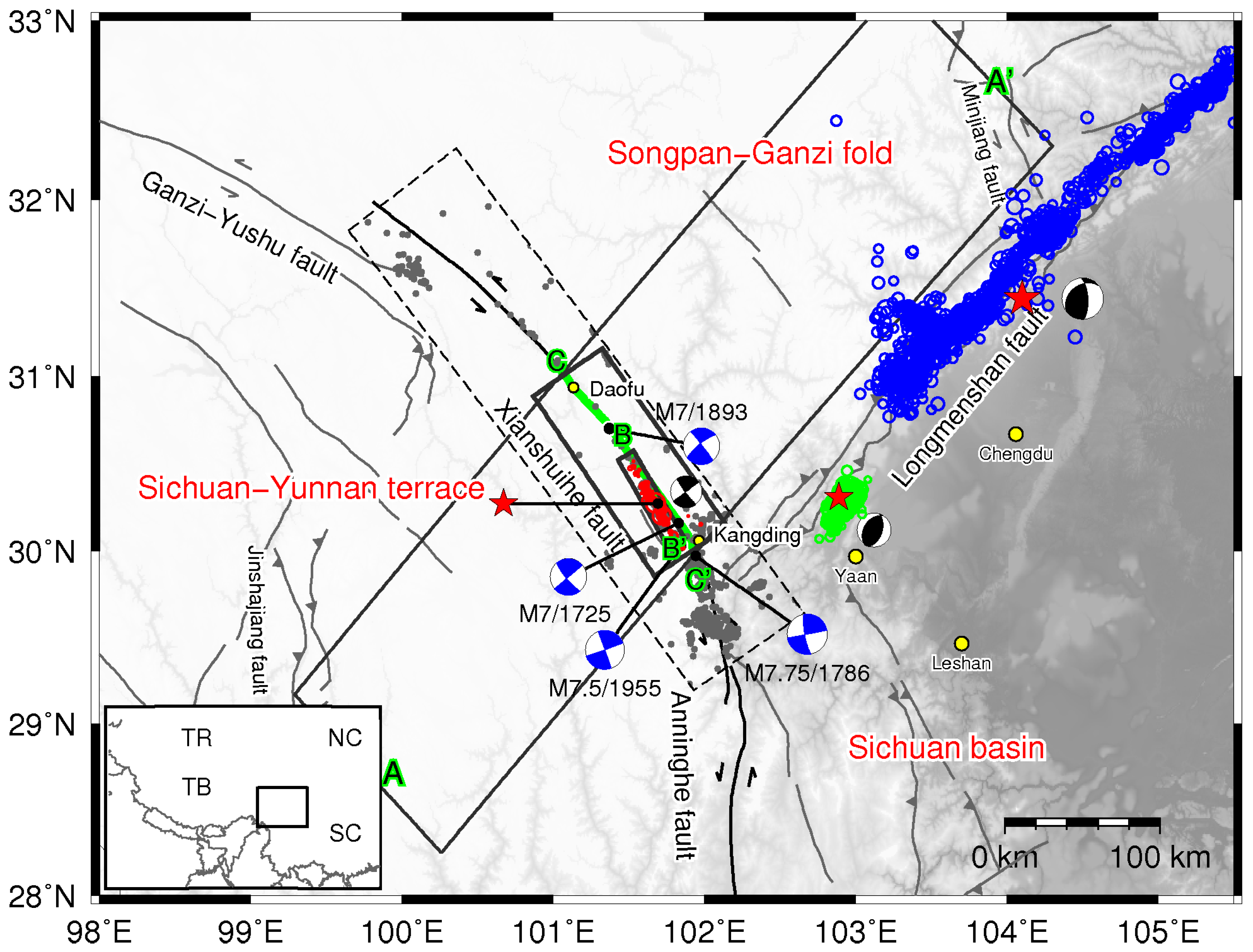
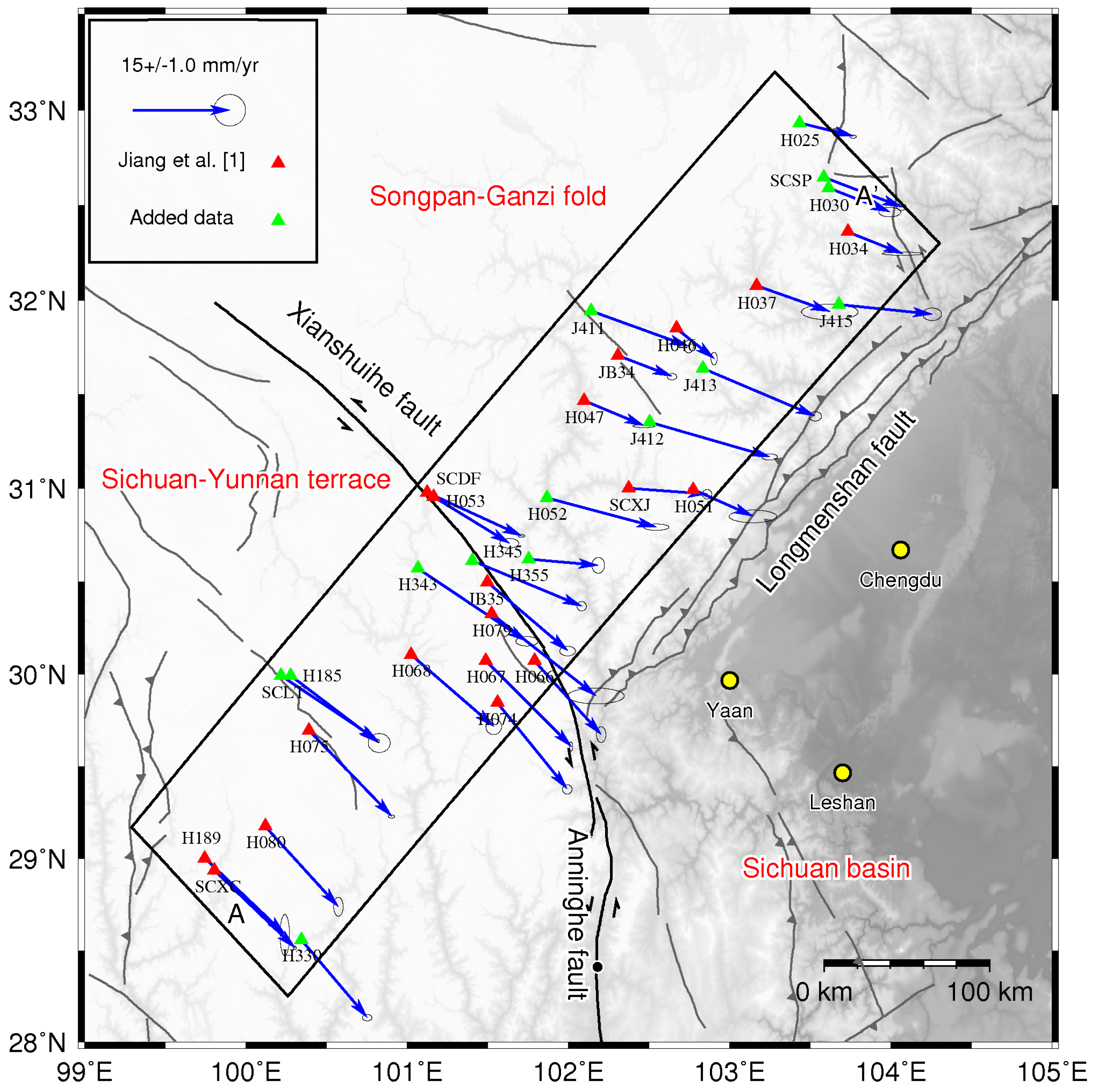
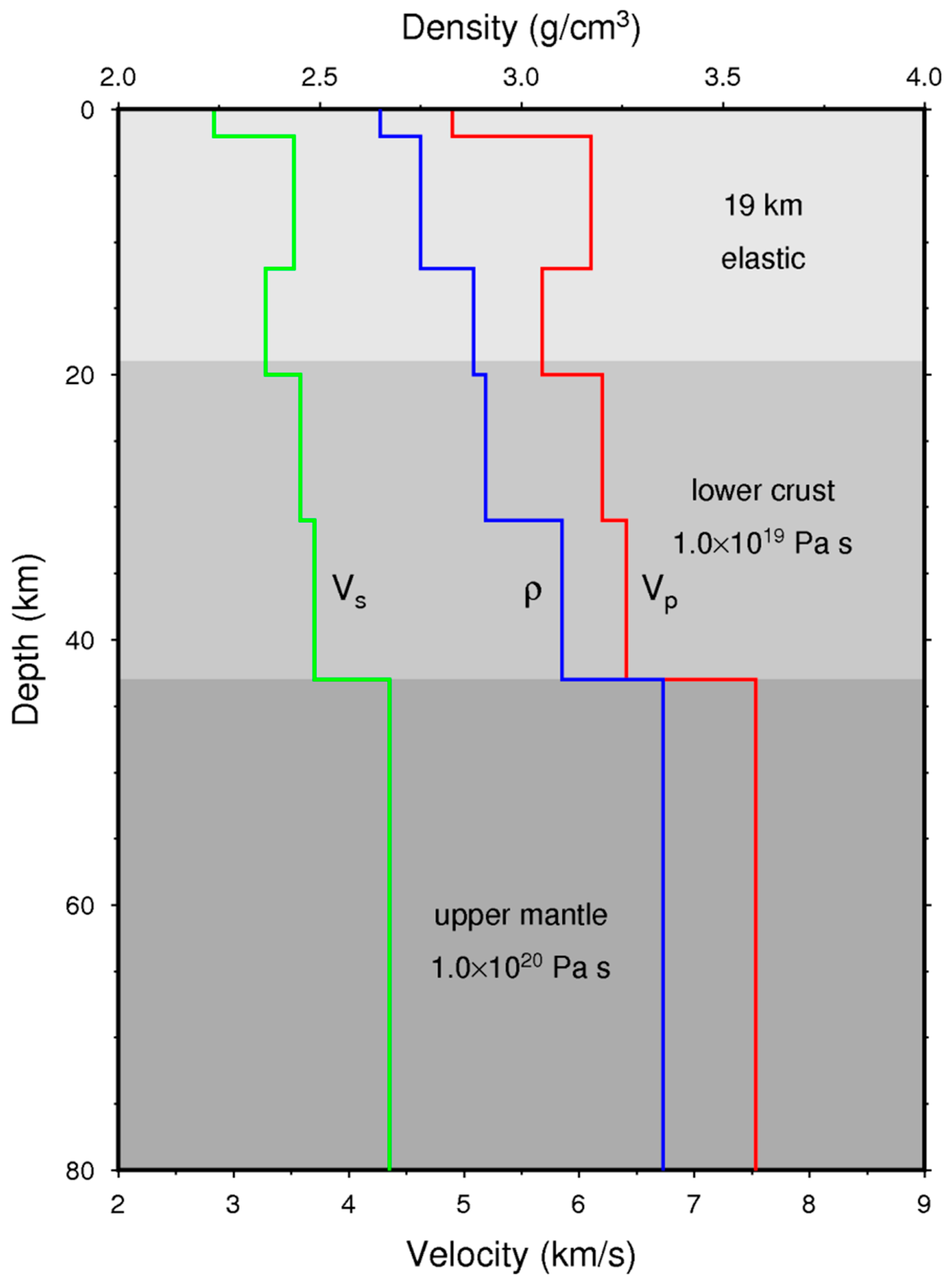
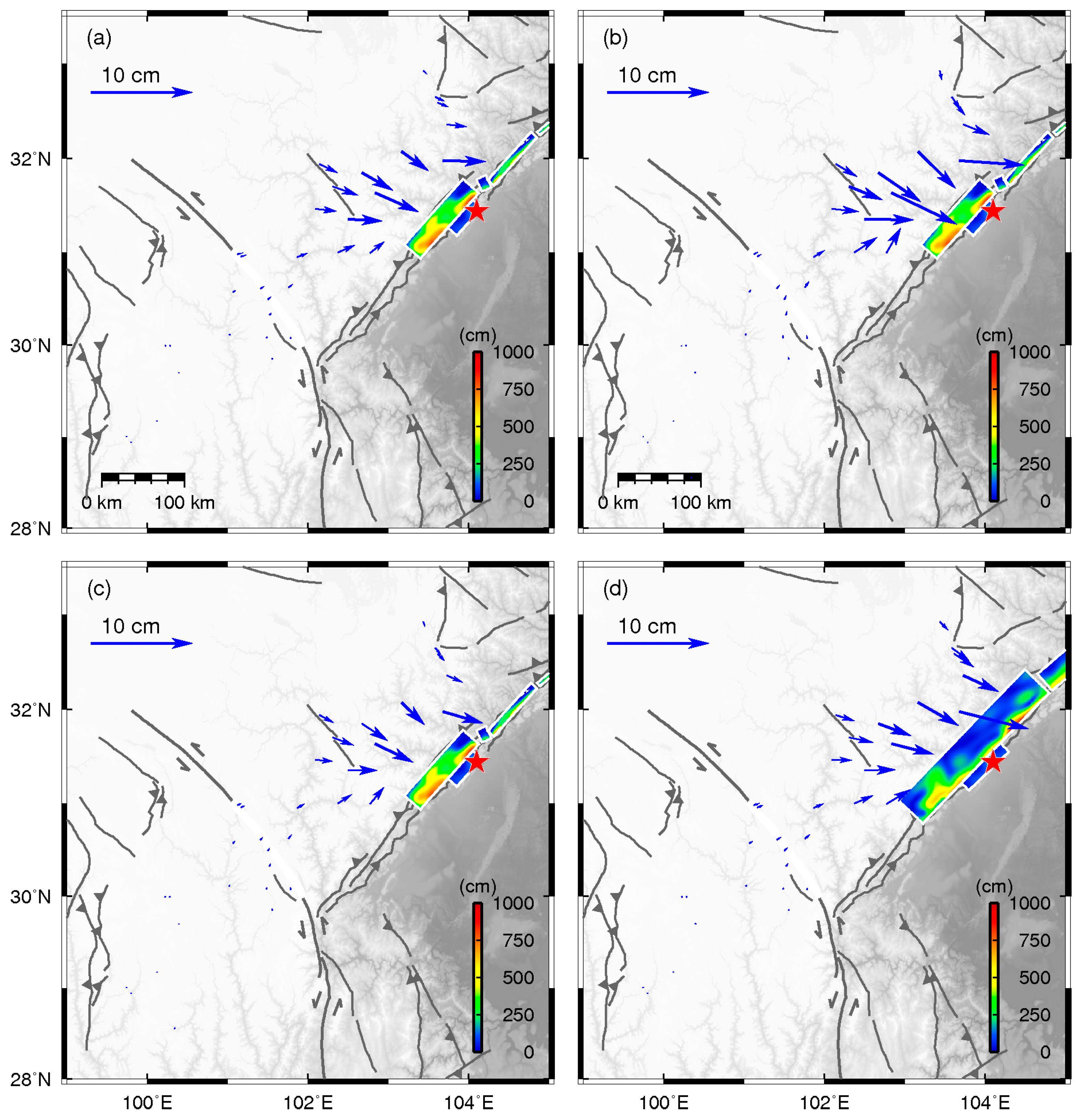

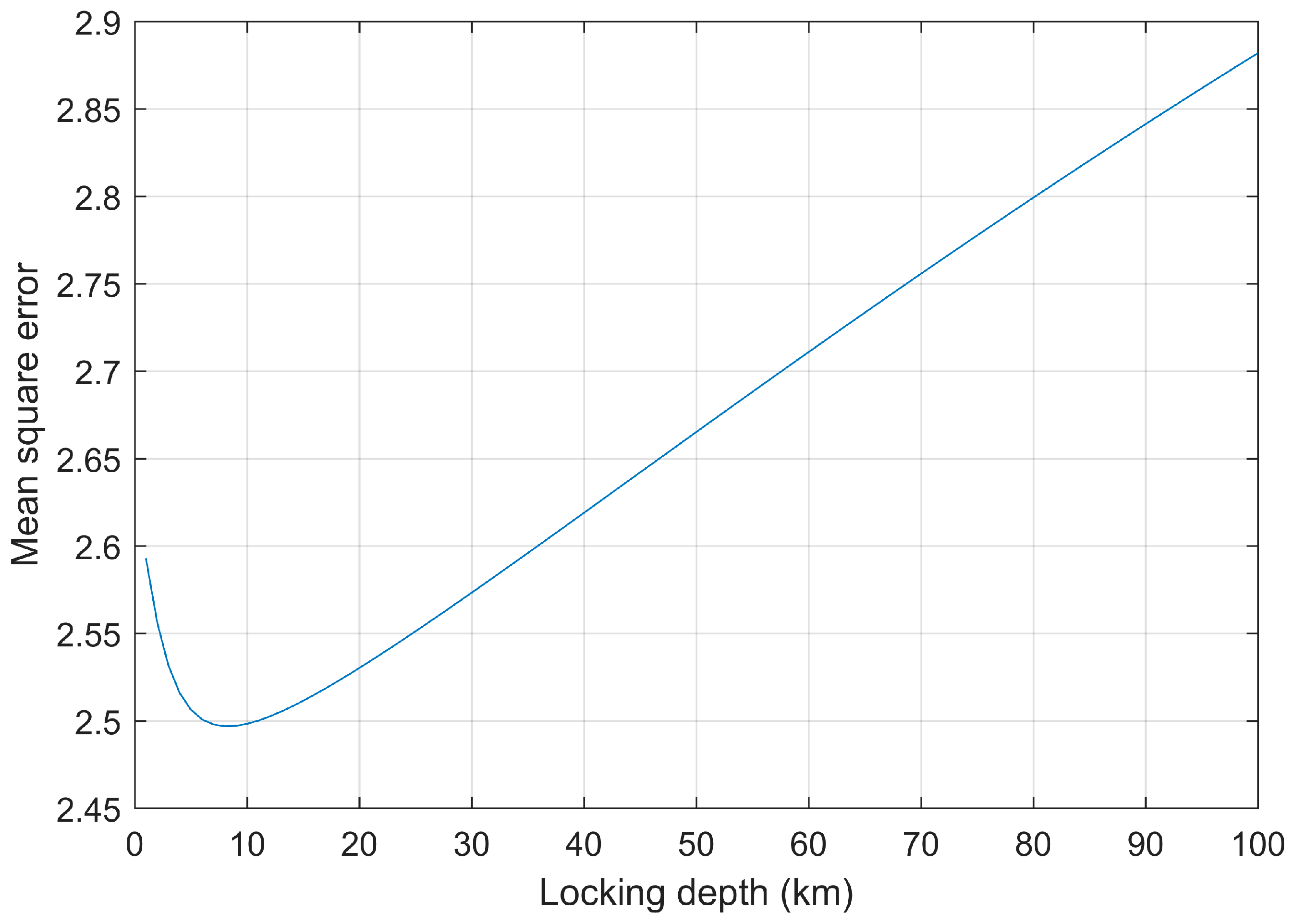

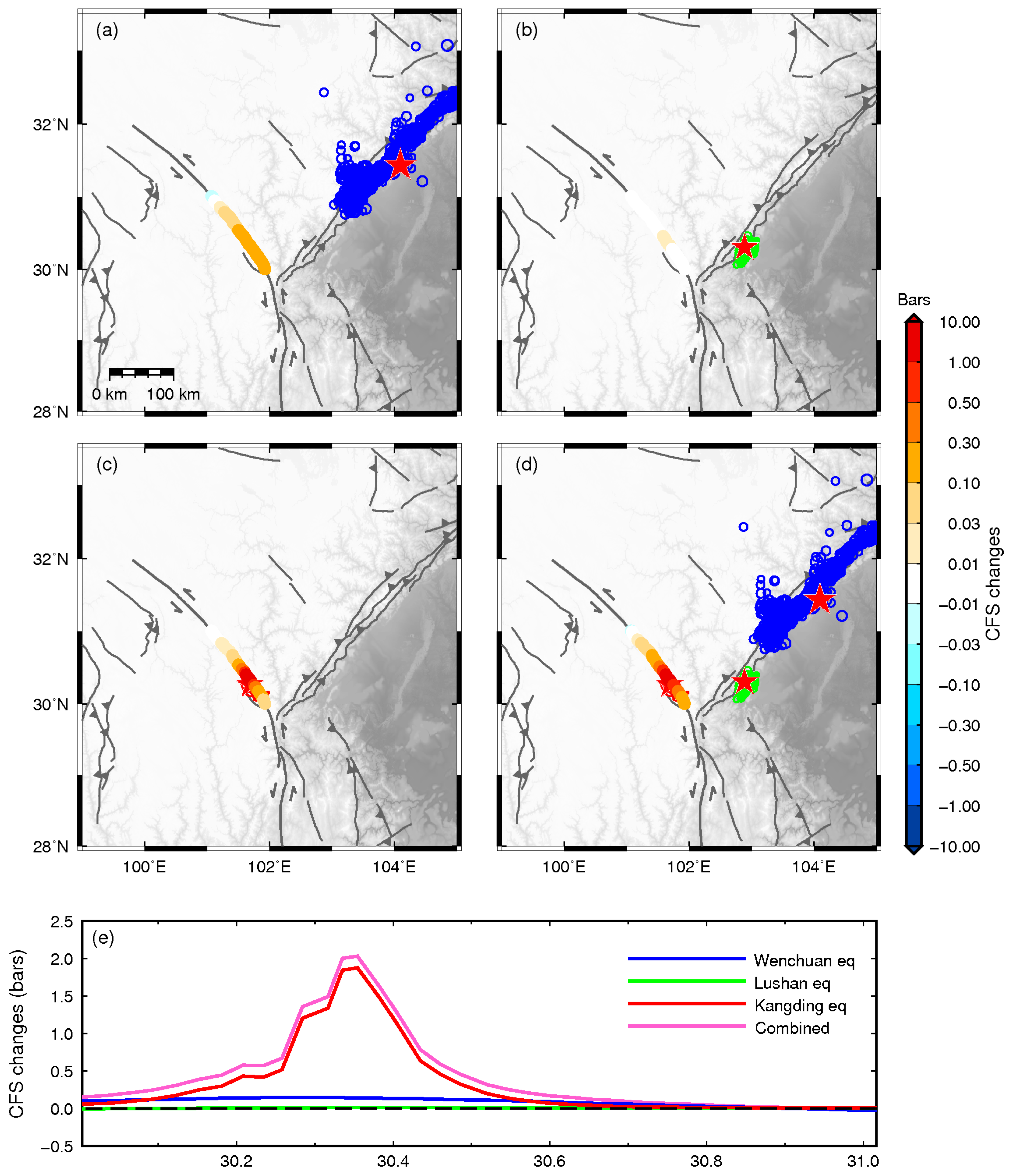
© 2018 by the authors. Licensee MDPI, Basel, Switzerland. This article is an open access article distributed under the terms and conditions of the Creative Commons Attribution (CC BY) license (http://creativecommons.org/licenses/by/4.0/).
Share and Cite
Guo, R.; Zheng, Y.; Tian, W.; Xu, J.; Zhang, W. Locking Status and Earthquake Potential Hazard along the Middle-South Xianshuihe Fault. Remote Sens. 2018, 10, 2048. https://doi.org/10.3390/rs10122048
Guo R, Zheng Y, Tian W, Xu J, Zhang W. Locking Status and Earthquake Potential Hazard along the Middle-South Xianshuihe Fault. Remote Sensing. 2018; 10(12):2048. https://doi.org/10.3390/rs10122048
Chicago/Turabian StyleGuo, Rumeng, Yong Zheng, Wen Tian, Jianqiao Xu, and Wenting Zhang. 2018. "Locking Status and Earthquake Potential Hazard along the Middle-South Xianshuihe Fault" Remote Sensing 10, no. 12: 2048. https://doi.org/10.3390/rs10122048
APA StyleGuo, R., Zheng, Y., Tian, W., Xu, J., & Zhang, W. (2018). Locking Status and Earthquake Potential Hazard along the Middle-South Xianshuihe Fault. Remote Sensing, 10(12), 2048. https://doi.org/10.3390/rs10122048





